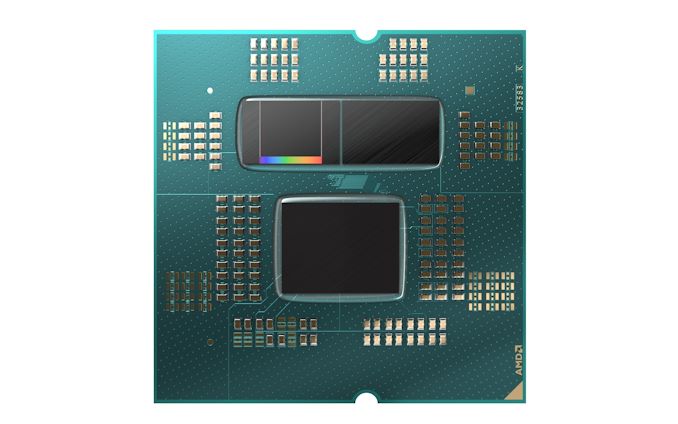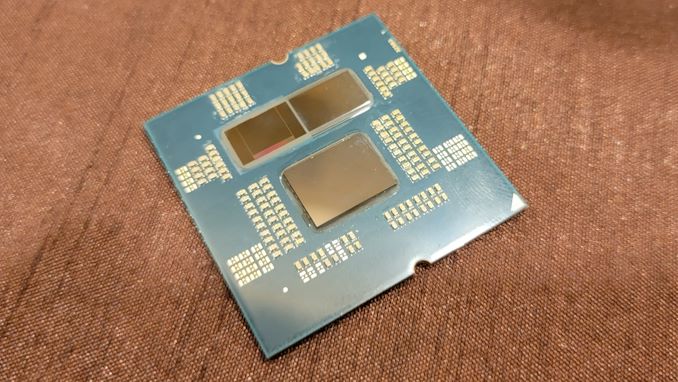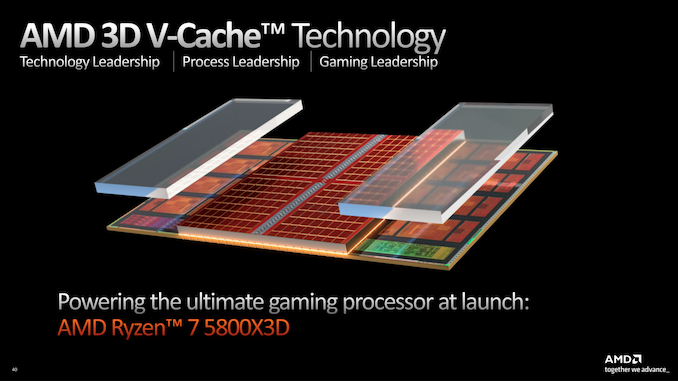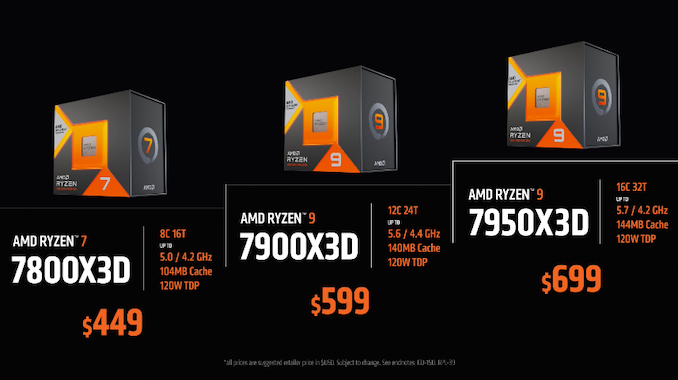AMD’s Ryzen 7000X3D Chips Get Release Dates: February 28th and April 6th, For $699/$599/$449
by Ryan Smith on February 1, 2023 9:45 PM EST- Posted in
- CPUs
- AMD
- X3D
- Ryzen 7000
- Raphael
- 3D V-Cache

AMD today has announced the launch date and prices for its eagerly anticipated Ryzen 7000X3D series processors. Aimed primarily at gamers, the company’s first L3 V-Cache equipped Ryzen 7000 processors will begin rolling out on February 28th, when the Ryzen 9 7950X3D and Ryzen 9 7900X3D go on sale for $699 and $599 respectively. This will be followed up by the Ryzen 7 7800X3D a bit over a month later, when it goes on sale for $449 on April 6th.
First announced to great fanfare during AMD’s CES 2023 keynote (and teased well before that), the Ryzen 7000X3D chips will be AMD’s second generation of consumer chips employing the company’s novel 3D stacked V-Cache technology. V-Cache allows AMD to stack a 64MB L3 cache die on top of their existing CCDs in order to expand the total L3 capacity of a Zen 3/4 CCD, going from 32MB to 96MB. And in the case of multi-CCD designs such as the Ryzen 9 7950X, bringing the total, chip-wide L3 cache pool to 128MB.
| AMD Ryzen 7000X/X3D Series Line-Up | |||||||
| AnandTech | Cores Threads |
Base Freq |
Turbo Freq |
L3 Cache |
TDP | Price (Street) |
Release Date |
| Ryzen 9 7950X3D | 16C / 32T | 4.2 GHz | 5.7 GHz | 128 MB | 120W | $699 | 02/28/23 |
| Ryzen 9 7950X | 16C / 32T | 4.5 GHz | 5.7 GHz | 64 MB | 170W | $583 | - |
| Ryzen 9 7900X3D | 12C / 24T | 4.4 GHz | 5.6 GHz | 128 MB | 120W | $599 | 02/28/23 |
| Ryzen 9 7900X | 12C / 24T | 4.7 GHz | 5.6 GHz | 64 MB | 170W | $444 | - |
| Ryzen 7 7800X3D | 8C / 16T | 4.2 GHz | 5.0 GHz | 96 MB | 120W | $449 | 04/06/23 |
| Ryzen 7 7700X | 8C / 16T | 4.5 GHz | 5.4 GHz | 32 MB | 105W | $299 | - |
| Ryzen 7 5800X3D | 8C / 16T | 3.4 GHz | 4.5 GHz | 96 MB | 105W | $323 | - |
Following the successful trial of the technology in the consumer space with AMD’s original Ryzen 7 5800X3D, which was released to positive acclaim back in the spring of 2022, AMD has developed a much broader lineup of V-Cache equipped Ryzen chips for this generation. This includes not only the 5800X3D’s direct successor, the 8 core Ryzen 7 7800X3D, but also, for the first time, chips employing multiple CCDs. These are the Ryzen 9 7900X3D and 7950X3D, which will offer 12 and 16 CPU cores, respectively.
Interestingly, AMD has gone for a non-homogenous design for these multi-CCD parts – rather than giving both CCDs V-Cache, AMD is only outfitting one of the CCDs with the extra L3 cache. The other CCD will remain a plain Zen 4 CCD, with its integrated 32MB of L3 cache. The unbalanced design, besides allowing AMD to control the costs of what’s still a relatively expensive technology to implement, will allow AMD to offer something close to the best of both worlds for their multi-CCD parts. The V-Cache equipped Zen 4 CCDs will offer 6 or 8 CPU cores backed by the massive L3 pool, for tasks that benefit from the larger cache size, while the vanilla Zen 4 CCDs will be unencumbered by the V-Cache, allowing them to clock higher for pure throughput workloads that wouldn’t benefit from the extra cache.
As with the original 5800X3D, AMD is aiming these chips at gamers in particular, as the complex, heavy-dataset nature of video games means they often benefit from having additional L3 cache on-hand. The 5800X3D was, depending on the game, around 15% faster than its vanilla Ryzen counterpart – at least so long as it wasn’t GPU limited. AMD is being a bit more coy this time around on making apples-to-apples comparisons against their regular Ryzen 7000 chips, so for now the only official performance figures available from AMD are pitting the chips against the 5800X3D. In lieu of that, a 15% improvement is a reasonable baseline given that the cache sizes haven’t changed in the last generation, but we’ll definitely want to take a closer look at the final chips to see if the additional L3 cache is as beneficial to Zen 4 as it was for Zen 3.
Back at their CES 2023 keynote, AMD announced the specifications for two-and-a-half of the chips, as well as an undetailed February launch date. With today’s announcement, AMD is finally filling in the rest of the details, as well as confirming that only part of the product stack is going to make that February launch date.

(Image Courtesy Tom's Hardware)
As previously noted, the Ryzen 9 7950X3D and Ryzen 9 7900X3D both launch on February 28th. The 16 core 7950X3D will hit the streets with a $699 price tag, while the 12 core 7900X3D will intro at $599. At current street prices, this represents roughly a $100 to $150 premium over the chips’ regular counterparts, with the 7950X selling for around $583, and the 7900X selling for around $444. Prices on AMD’s top AM5 chips have come down a decent bit since their 2022 launch, so the new X3D SKUs are coming in at similar launch prices as their non V-Cache counterparts. Put another way, whereas $699 would get you a 16 core 7950X in September, come February it will get you the same chip with an additional 64MB of L3 cache.
Other than benchmarks, at this point the only detail we don’t have on the 7950X3D and 7900X3D are the clockspeeds for the V-Cache equipped CCDs. AMD’s quoted turbo clockspeeds are for the vanilla CCD, so it’s unclear just how much clockspeeds have been lowered for the V-Cache CCD. But taking a hint from AMD’s sole single CCD X3D part, the 7800X3D, we see that part has a top clockspeed of just 5.0GHz. So we’d expect something similar for the V-Cache CCDs on the Ryzen 9 parts.
Speaking of the Ryzen 7 7800X3D, we finally have the full specifications on AMD’s most straightforward X3D part. Back in January AMD hadn’t locked down the base clockspeeds on this part, but as of today we finally have the answer: 4.2GHz. The chip will, in turn, be able to turbo as high as 5.0GHz as previously noted.
The cheapest of the Z3D parts, with a price tag of $449, the 7800X3D will also be the laggard of the group, with the chip not launching until April 6th. AMD has not explained the gap in launch dates, but it’s reasonable to assume that AMD is prioritizing the assembly and shipping of their more expensive Ryzen 9 SKUs. In any case, at current street prices the 7800X3D will carry a $150 premium over the $299 7700X, making it a full 50% more expensive, assuming these street prices hold through April. This happens to be the same price the 5800X3D launched at, so AMD is technically just holding the line here, but it does underscore how price cuts on the rest of the Ryzen 7000 lineup have made the standard chips very competitive on a price/performance basis.
In any case, we’ll have more on AMD’s first V-Cache equipped Zen 4 chips later this month. Besides taking an in-depth look at the performance improvements brought about by the larger L3 cache, the other major factor driving performance is going to be the Windows thread scheduler. As this is AMD’s first asymmetric Ryzen CPU, it will be up to Windows and AMD’s chipset driver to figure out which CCD to place threads on for the 7950X3D/7900X3D. So this month’s launch is going to require that AMD’s hardware and software offerings are in sync in order for the company to make a good first impression.












64 Comments
View All Comments
Jeff72 - Wednesday, February 1, 2023 - link
Subject $499 price needs correction. Second to last sentence has 7900X3D/7900X3D and I assume you meant 7950X3D/7900X3D.Ryan Smith - Wednesday, February 1, 2023 - link
Ack! You are correct. There's too many nines in all of these prices!Thanks!
Hulk - Wednesday, February 1, 2023 - link
One v-cache lower clocked chiplet, one without v-cache and clocked higher. Could be construed as a hybrid approach.godrilla - Wednesday, February 1, 2023 - link
One that can make or break the Zen4 3d R9s if not scheduled to perfection. Will professionals pay more for potentially lower performance in professional apps from a significant amount of cores with higher boost and higher base clocks on a 7950x cpu that will be selling for about $120 less?Cooe - Thursday, February 2, 2023 - link
Why would professionals be looking at the X3D parts? O_o🤦😑 They are EXPLICITLY MARKETED TOWARDS GAMERS! (And multi-use users who heavily game). Literally NOBODY building a pure workstation is shopping the X3D chips unless they KNOW one of their major workloads responds to extra cache!And for any "mixed workload" users, single-core/lightly threaded boost isn't faster/higher on a regular R9 7950X vs the R9 7950X3D! While all-core boost won't be that much lower than the regular parts! (Think non-X Ryzen 7000 NOT R7 5800X3D).
The vanilla 7950X hits about ≈5.1GHz on all-cores while the R7 7800X3D shows that a Zen 4 X3D CCD can hit 5GHz. Aka, we're talking about a loss of only like -≈100-300MHz here on the all-core boost (≈4.8-5GHz vs ≈5.1GHz) for the highest clocking & core count part! (Or basically EXACTLY what you'd expect from the -50W TDP reduction going from 170W to 120W!)
Anyone who isn't a complete & utter idiot and who ACTUALLY uses their PC to game a lot won't even REMOTELY CARE about losing a mere ≈6% of their all-core boost clock (≈4.8GHz vs ≈5.1GHz) in productivity workloads in exchange for X3D's absolutely GARGANTUAN gaming performance gains! And if losing that much clock-speed/productivity performance IS a "game ender" for you, then you were never actually considering an X3D chip in the first place!
godrilla - Thursday, February 2, 2023 - link
Wait so you are saying that professionals that do not game would not be smart for buying these Zen 4 3d R9s because the non 3d ones are significantly cheaper?godrilla - Thursday, February 2, 2023 - link
Update same goes for people that just game*. This product is just a niche of niche product. Don't forget the non 3d parts don't stop being good at gaming either.godrilla - Thursday, February 2, 2023 - link
Update the 7950x can oc to all core overclock to 5.8 ghzhttps://www.techpowerup.com/299126/amd-ryzen-9-795...
or 5.95 ghz according to
https://youtu.be/yXU1FJxbToY
fyi
Zoolook - Saturday, February 4, 2023 - link
Correct and the gain is only massive in certain games and at lower to mid resolution otherwise you are gpu bottlenecked anyway, a niche of a niche is a very apt description.Targon - Wednesday, February 8, 2023 - link
For those who pay attention, that is what everyone has been saying. The vast majority of programs, and even some games, do not get extra performance from the extra cache. In the case of the 5800X3D, you already saw how the CPU was actually slower in many/most programs compared to the Ryzen 7 5800X due to the clock speed difference and the cache not resulting in higher performance. The Zen4 chips with 3D stacked cache won't have the clock speed hurt quite as much, and for the Ryzen 9 versions, the 3D stacked cache is only on one of the CCDs, not both, so it won't even hurt performance for most programs.For the PROFESSIONAL market that actually uses 16+ cores, the X3D would result in lower performance in those professional applications due to lower clock speeds on one CCD. It would be better to get the non-3D cache versions at that point.